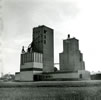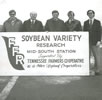 |
Historical Timeline
|
|
 |
 |
|
|
| |
|
|
|
- Second feed mill, used for bulk production, at LaVergne begins operations. It’s TFC’s fourth mill.
- TFC grows at such a rate t decides to set up divisions rather than product areas. The crops division includes fertilizers, seed, and chemicals; in 1971, material handling is added. The feed division is formed in 1970. The purpose of these changes is to keep functions together that have common characteristics.
- The seed plant, destroyed by fire in late 1969, is rebuilt.
- Radial tires are introduced to Co-op customers. This passenger tire was originally designed for the rugged high-speed driving of central and western Europe and gives up to 40,000 miles of tread wear. Co-op’s first such tire was the “Co-op Radial Wide.”
- A trend in the construction of separate car care centers is seen as a result of an emphasis launched two years earlier. These new centers also expand business into automotive accessories.
|
 |
|
|
 |
|
 |
|
|
 |
 |
 |
|
|
| |
|
|
|
- A metal fabrication plant is added at LaVergne and begins production on Sept. 1. The plant is capable of turning out 90 gates per day and produces three types of gates at first: heavy-duty gates with chain link, tube-type gates, and a panel gate.
- Co-op Agri-Master tractor tire, designed for “big, modern tractors,” is introduced.
- Prescription “blended” fertilizers becomes a trend for growers.
- New symbols for TFC’s Division are introduced. Versions of these logos are still in use today.
- The “one-stop cropping” concept is introduced under the newly formed Crop Division. The promotion encourages farmers to use Co-op as the one source for al their production needs: seed, plant food, chemicals, service, and custom applications.
|
 |
|
|
 |
|
 |
|
|
 |
 |
 |
|
|
| |
|
|
|
- Universal cooperatives is formed by the merger of National Cooperatives of Albert Lea, Minn., and United Cooperatives of Albert Lea, Minn., abd United Cooperatives of Alliance, Ohio. TFC is a member-owner of Universal, headquartered at Bloomington, Minn. Today, Universal continues to serve the Co-op system in Tennessee by manufacturing, processing, and purchasing farm and home supplies such as automotive items, chemicals, twine.
- FFR 666 and FFR 777 soybeans and TFC 200 corn are developed as the first seed varieties to be owned, controlled, and marketed under the Co-op trademark.
|
 |
|
|
 |
|
 |
|
|
 |
 |
 |
|
|
| |
|
|
|
- The second Tenco feed mill, used for bulk production, becomes operational.
- A.L. Jerdan known as the “father of Co-op: in Tennessee, dies at age 85.
- Membership approves change in bylaws to et the term of each district director on TFC’s board to a single seven-year term.
- Co-op Golden Flow liquid supplement introduced for winter 1973.
- CF Industries begins Farmers Chemical Association, TFC’s major source of nitrogen. CF, a cooperatively owned manufacturer and distributor of basic fertilizer materials, will become TFC’s main plant food supplier.
|
 |
|
|
 |
|
 |
|
|
 |
 |
 |
|
|
| |
|
|
|
- Personnel from the Hardware and Automotive/Petroleum Departments are brought together to firm Hardware and Petroleum Divisions. There are now four operating divisions: Crops, Feed, Petroleum, and Hardware.
- The “energy crisis” spawns national speed limit of 55 miles per hour on Jan. 2, 1974. The crisis is also a big topic at the manager’ meeting. The fuel shortage prompts cooperatives to protect their customers by providing supplies when other businesses would not. TFC and 18 other major farm supply regionals form international Energy Cooperatives, Inc., to negotiate directly with oil-producing countries for fuel needed by cooperatives to meet farm and rural energy needs.
- TFC completes the expansion of Halls Seed with modern seed cleaning and processing equipment for soybeans and wheat. Grand opening is held March 7 at the facility, which operates on a total gravity system.
- TFC Marketing Services is sold to GoldKist, Inc.
|
 |
|
|
 |
|
 |
|
|
 |
 |
 |
|
|
| |
|
|
|
- Portable hay feeders are now available at the Co-op – square and round models manufactured at LaVergne Metal Fabrication Plant.
- Tend-r-leen introduced as a revolutionary new feed product designed to allow cattlemen to finish beef and dairy steers to market weight. The product, a protein supplement fed with whole shelled corn to finish cattle swiftly and easily, becomes a flagship product for TFC for years to come.
- TFC passes the $1 billion mark in total sales from 1945 to 1975, announced at TFC’s annual meeting Dec. 18.
|
 |
|
|
 |
|
 |
|
|
 |
 |
 |
|
|
| |
|
|
|
- Talk of converting to the metric system nationwide prompts the Tennessee Department of Agriculture to begin educating citizens on the new method of measurement. No exact time was set for the conversion from the present English system, and untimately the change never took place. Under the metric system, farmers would have measured land in hectares, be paid for milk in kilograms, buy gas by the liter, harvest grain by the quintal, take trips by kilometers, and measure temperature in Celsius.
- FFR Mid-South Research Station opens in Covington on June 10, 1976. The purpose of the station is to develop improved soybean varieties.
- A new position of sales manager is created to coordinate sales efforts and promotional programs; James Walker is named to the newly created position.
|
 |
|
|
 |
|
 |
|
|
 |
 |
 |
|
|
| |
|
|
|
- TFC joins three other cooperatives in forming Cooperative Seeds Inc., to produce and process hybrid seed corn. Te plant in Elzaville, Ind., is finished in August 1978.
- A larger cold storage unit is installed at the LaVergne warehouse for refrigerated animal health products.
|
 |
|
|
 |
|
 |
|
|
 |
 |
 |
|
|
| |
|
|
|
- A modern new testing laboratory is completed at LaVergne. The 7,000-square-foot facility replaces the former lab constructed in 1956. The lab, which is called the Quality Assurance and Analytical Laboratory today, continues its purpose of testing feed, seed, and fertilizer samples as well as forage samples for farmers.
- TFC’s summer internship program starts in the late 1970’s.
- New 15-15-15- plant food is introduced for lawn and garden in March.
- A 13,000-suqare-foot expansion is added to the TFC office building at LaVergne. It’s the second addition to be built since 1960.
- The first Co-op group meets at the Opryland Hotel for the winter managers’ meeting on Jan. 19 and 20, 1978. TFC’s annual meeting is held at the Opryland Hotel for the first time Nov. 26-28, 1978. The hotel had been completed in late 1977.
- The system’s first 24-hour fuel pumps, operated by a key system, are installed at Haywood Farmers Co-op for both diesel and gasoline. Crockett Farmers Co-op added a similar system later in the year.
|
 |
|
|
 |
|
 |
|
|
 |
 |
 |
|
|
| |
|
|
|
- TFC, AFC, MFC Services of Mississippi form Red Panther Chemical Corporation.
- An announcement is made March 29 about sixth feed mill to be built in Lewisburg. Due to high interest costs and economic consideration, the plant was never built.
- Hardware and Petroleum/Automotive Departments are combined to form Petroleum-Hardware Division.
- Statewide, the Co-op system experiences a boom in the costruction of bulk fertilizer plants.
- Gasohol is offered at 29 local Co-ops and described as the “Hottest thing around.” The mixtures consists of 10 parts of 200-proof ethanol and 90 parts gasoline. Customers waited in line for this biofuel, hailed as “a patriotic thing to do” to help the country become less dependent on oil-producing countries.
|
 |
|
|
 |
|
 |
|
|
 |
|
  |
|